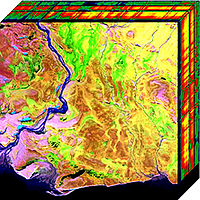
Photo from wikipedia
An estimated 30–70% of available medications in low-income countries and conflict states are of low quality or counterfeit. Reasons for this vary but most are rooted in regulatory agencies being… Click to show full abstract
An estimated 30–70% of available medications in low-income countries and conflict states are of low quality or counterfeit. Reasons for this vary but most are rooted in regulatory agencies being poorly equipped to oversee quality of pharmaceutical stocks. This paper presents the development and validation of a method for point-of-care drug stock quality testing in these environs. The method is termed Baseline Spectral Fingerprinting and Sorting (BSF-S). BSF-S leverages the phenomena that all compounds in solution have nearly unique spectral profiles in the UV spectrum. Further, BSF-S recognizes that variations in sample concentrations are introduced when preparing samples in the field. BSF-S compensates for this variability by incorporating the ELECTRE-TRI-B sorting algorithm, which contains parameters that are trained in the laboratory using authentic, proxy low quality and counterfeit samples. The method was validated in a case study using fifty samples that include factually authentic Praziquantel and inauthentic samples prepared in solution by an independent pharmacist. Study researchers were blinded to which solution contained the authentic samples. Each sample was tested by the BSF-S method described in this paper and sorted to authentic or low quality/counterfeit categories with high levels of specificity and sensitivity. In combination with a companion device under development using ultraviolet light emitting diodes, the BSF-S method is intended to be a portable and low-cost method for testing medications for authenticity at or near the point-of-care in low income countries and conflict states.
Journal Title: PLOS ONE
Year Published: 2023
Link to full text (if available)
Share on Social Media: Sign Up to like & get
recommendations!